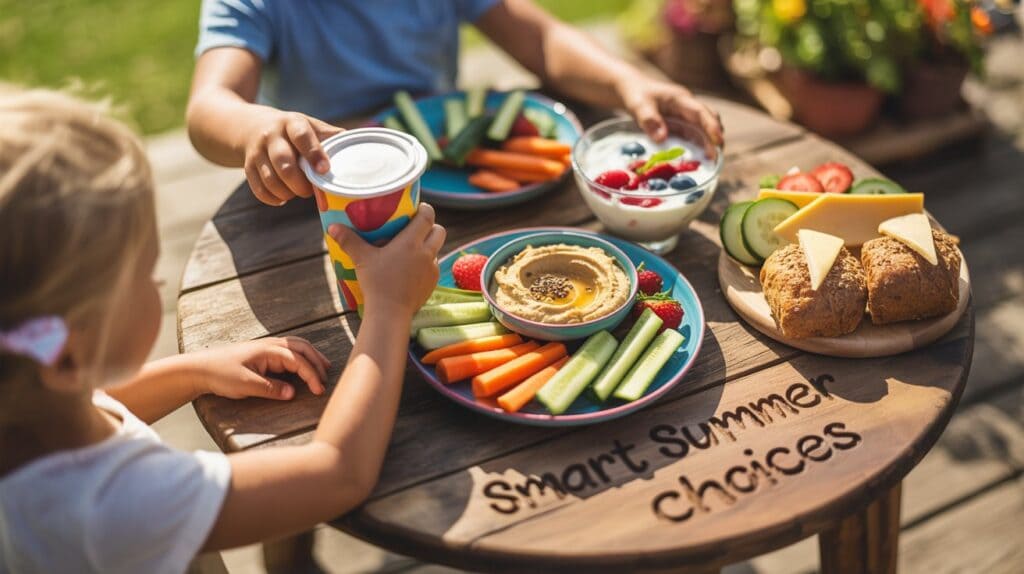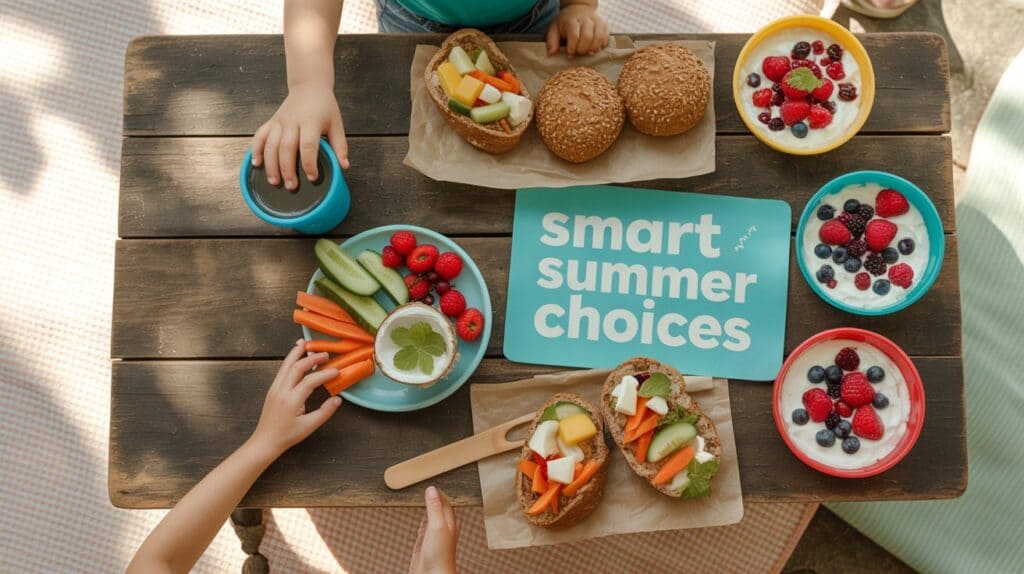
Introduction
As the temperature rises and the days grow longer, children’s activity levels often soar during the summer months. With outdoor play, sports, camps, and vacations becoming part of daily life, ensuring that kids stay well-nourished and hydrated is essential for their health, energy, and immune function.
Summer brings an abundance of fresh, colorful fruits and vegetables, many of which are packed with essential nutrients that support growth and development. However, children also face increased risks of dehydration, heat exhaustion, and digestive issues due to poor dietary choices in hot weather.
This guide explores the best summer foods for children, combining scientific insights, recommendations from health professionals, and SEO-friendly advice to help parents make smart, seasonal food choices.
Why Summer Nutrition Matters for Children
Children require balanced meals that cater to their rapid development, especially during a time when physical activity spikes and environmental stressors like heat increase.
☀️ Key Summer Health Challenges for Kids:
- Dehydration from increased sweating.
- Heat-related fatigue or reduced appetite.
- Preference for sugary, processed snacks like ice cream, soda, or chips.
📘 According to Wikipedia, hydration and nutrition are closely linked: “Children’s hydration needs increase with outdoor exposure, and poor food choices may contribute to heat-related illnesses.”

The Top Nutritional Needs of Children in Summer
🥤 1. Hydration and Electrolyte Balance
Children lose fluids faster due to their smaller bodies and higher surface area to weight ratio.
🧪 A 2022 Journal of Pediatric Health study revealed that over 60% of school-aged children showed signs of mild dehydration during summer holidays.
✅ Best Hydrating Foods:
| Food | Water Content (%) | Nutritional Bonus |
|---|---|---|
| Watermelon | 92% | Vitamin C, lycopene |
| Cucumbers | 95% | Potassium, fiber |
| Strawberries | 91% | Antioxidants |
| Oranges | 87% | Vitamin C, folate |
| Zucchini | 94% | Magnesium, vitamin B6 |
Keyword Tip: Include terms like “hydrating summer snacks for kids”, “fruits to prevent dehydration in children” for SEO visibility.

🥗 2. Energy and Growth Support
Summer can reduce appetite in children due to heat, but nutrient density is key. Foods must be both calorie-efficient and micronutrient-rich.
✅ High-Energy, Kid-Friendly Foods:
- Bananas: Easy to digest, full of potassium.
- Nut butters: Healthy fats and proteins (spread on whole grain toast or fruits).
- Boiled eggs: Portable protein source with essential B vitamins.
- Yogurt: Cool, calcium-rich, and gut-friendly.
🥛 A study in The American Journal of Clinical Nutrition (2023) emphasizes that protein intake during summer helps maintain muscle mass in growing children, especially those engaged in physical activity.
Top 10 Summer Superfoods for Children
| Superfood | Benefits | Serving Ideas |
|---|---|---|
| Watermelon | Hydration, skin health | Sliced, blended, or in fruit skewers |
| Greek Yogurt | Calcium, probiotics | Topped with berries or honey |
| Carrots | Vitamin A for vision | Raw sticks or with hummus |
| Berries | Antioxidants, fiber | In smoothies or frozen |
| Leafy Greens (spinach, kale) | Iron, folate | Hidden in wraps or blended in smoothies |
| Corn | Fiber, natural sugar | Boiled or grilled |
| Avocados | Healthy fats, potassium | Mashed or in sandwiches |
| Chia Seeds | Omega-3, fiber | In pudding or smoothies |
| Peaches and Plums | Digestive support | Fresh or grilled with honey |
| Coconut Water | Electrolytes, hydration | Served cold as a drink alternative |
Healthy Summer Snack Ideas for Kids
Kids love snacks, especially during playtime. Instead of reaching for sugary drinks or packaged snacks, try these fun, nutritious alternatives:
🍓 1. Frozen Fruit Pops
- Blend mango, banana, and Greek yogurt, then freeze in molds.
- Add chia seeds for extra fiber.
🍌 2. Nut Butter Banana Boats
- Slice a banana in half, spread almond or peanut butter, and top with granola.
🥒 3. Veggie Dippers
- Sliced carrots, celery, cucumbers with hummus or tzatziki dip.
🧃 4. Homemade Electrolyte Drink
- Mix coconut water, a splash of orange juice, and a pinch of sea salt for a natural sports drink.
💡 Pediatrician Dr. Tanya Altmann, author of What to Feed Your Baby, recommends snacks with a balance of protein, fiber, and healthy fat to maintain energy levels in hot weather.
Foods to Limit or Avoid in Summer
While treats are part of summer fun, excessive intake of certain foods can increase health risks:
| Food | Why to Limit |
|---|---|
| Sodas & Soft Drinks | High in sugar, no hydration benefits |
| Ice Cream & Frozen Desserts | High in saturated fats and added sugars |
| Fried Foods | Difficult to digest in hot weather |
| Artificially Colored Juices | Often lack real fruit and contain preservatives |
📚 The World Health Organization (WHO) warns that high sugar consumption in children contributes to obesity, metabolic syndrome, and tooth decay—especially during holiday seasons.

Incorporating Summer Foods into Family Meals
Encouraging kids to eat healthily starts with family participation and creative presentation.
👨👩👧👦 Meal Tips:
- Create a rainbow plate challenge: encourage kids to include 5 colors in every meal.
- Involve children in choosing fruits at local markets.
- Use fun shapes and molds to present fruits and vegetables.
🍽️ Sample Summer Meal Plan:
| Meal | Sample Dish | Notes |
|---|---|---|
| Breakfast | Greek yogurt with berries and granola | Rich in protein and antioxidants |
| Snack | Frozen watermelon cubes | Refreshing and hydrating |
| Lunch | Whole grain wrap with hummus, lettuce, shredded carrots, and cheese | Balanced and portable |
| Snack | Sliced peaches with cottage cheese | Protein and vitamins |
| Dinner | Grilled chicken, corn on the cob, and a spinach-strawberry salad | Full meal with iron, fiber, and protein |
Medical and Nutritional Insights
Recent research continues to stress the importance of seasonal eating and hydration strategies for children:
- 🧬 A 2023 article in The Lancet Child & Adolescent Health highlights that children’s digestive and immune systems function better with seasonal, whole foods rather than year-round processed options.
- 🥼 The Harvard T.H. Chan School of Public Health encourages parents to limit sugar-sweetened beverages and focus on natural hydration through water and fruit.
Conclusion: Feed the Fun with Health in Mind
Summer is a time of joy, energy, and exploration for children—but it can also be a season of nutritional pitfalls if not managed with care. By prioritizing hydrating fruits, seasonal vegetables, and balanced snacks, parents can ensure their children stay energized, focused, and protected against the heat.
✅ Key Takeaways:
- Offer high-water-content fruits and vegetables throughout the day.
- Prepare easy, healthy snacks to avoid processed alternatives.
- Avoid sugary drinks and fried foods, especially in hot weather.
- Encourage children to participate in food selection and meal prep.
With a thoughtful approach to summer nutrition, your child can thrive physically and emotionally while making the most of the season’s bright days.
References
- Children’s nutrition in summer – Wikipedia
- The Journal of Pediatrics (2022) – “Hydration and Electrolyte Balance in Active Children”
- The American Journal of Clinical Nutrition (2023) – “Protein and Growth in Children During Summer Activity”
- The Lancet Child & Adolescent Health (2023) – “The Role of Seasonal Foods in Digestive Health”
- World Health Organization (WHO) – “Child Health and Sugar Intake Guidelines”
- Harvard T.H. Chan School of Public Health – “Healthy Eating for Kids: Seasonal Strategies”
- Journal of Pediatric Health (2022) – “Heat and Nutritional Impact in School-Aged Children”






